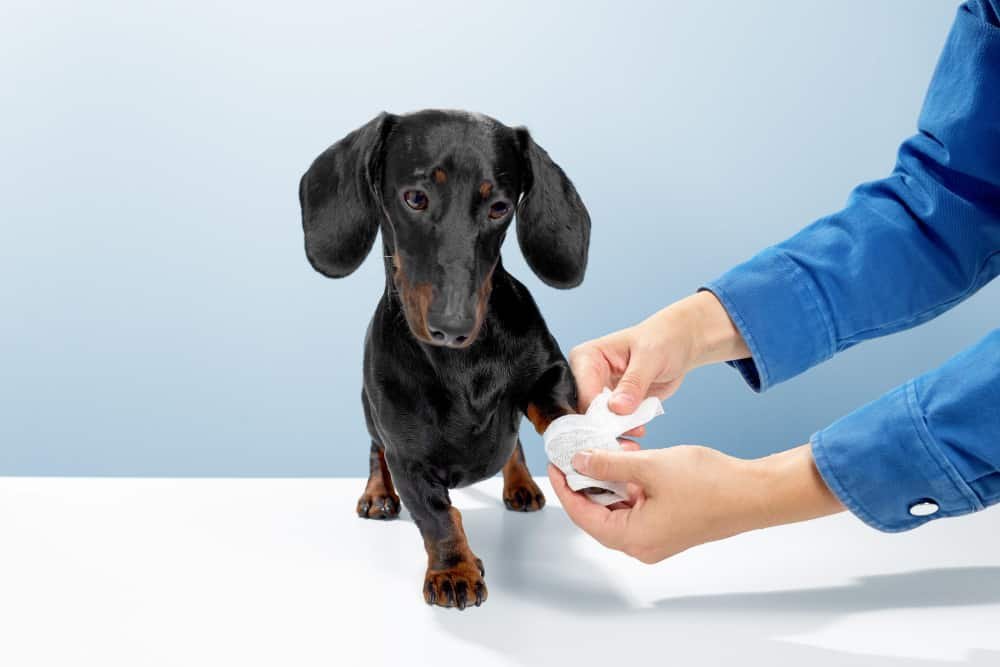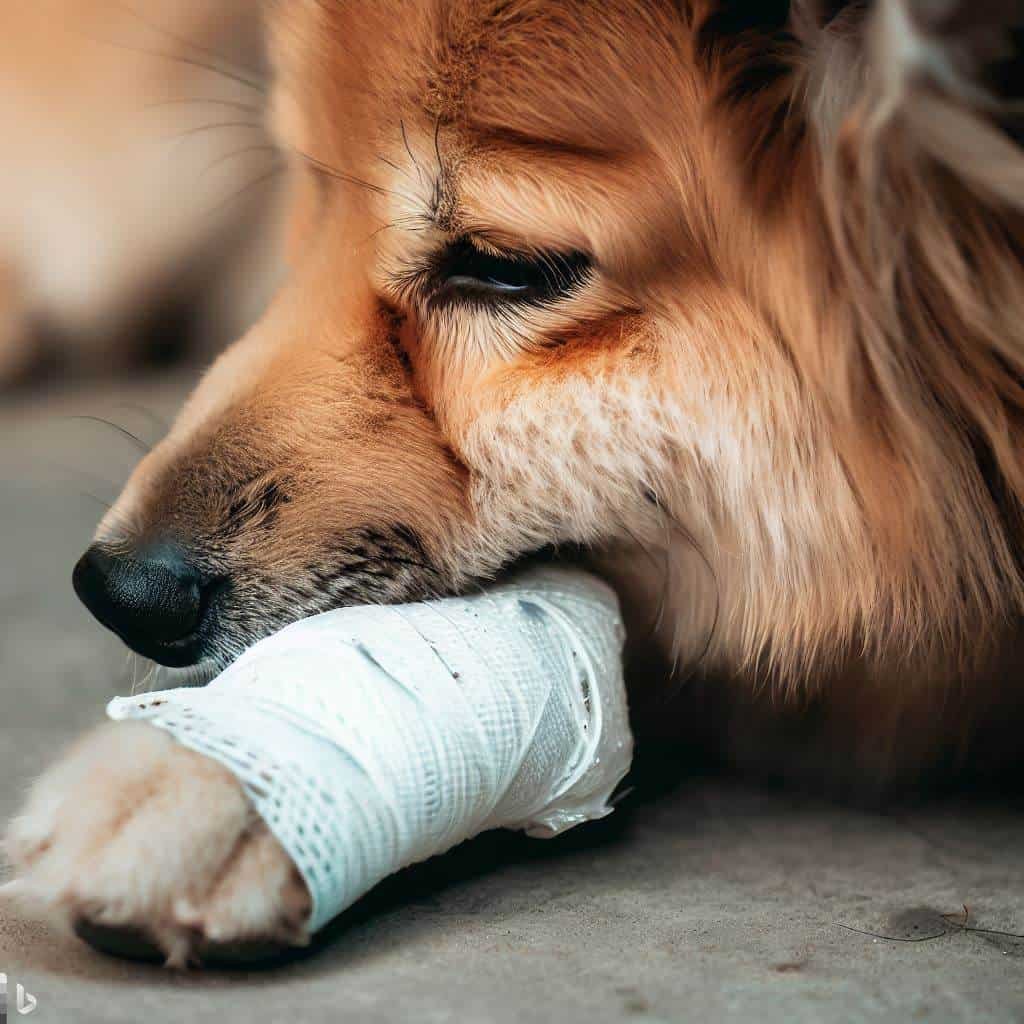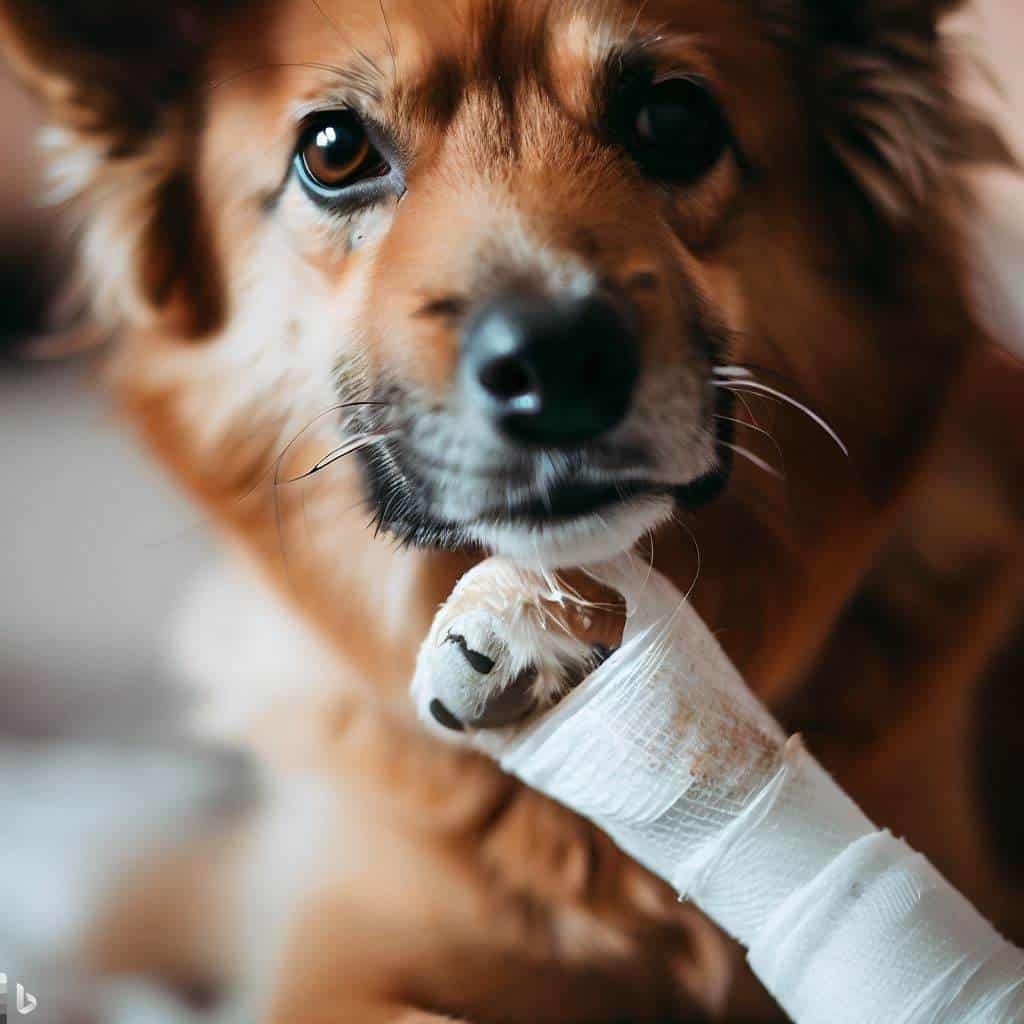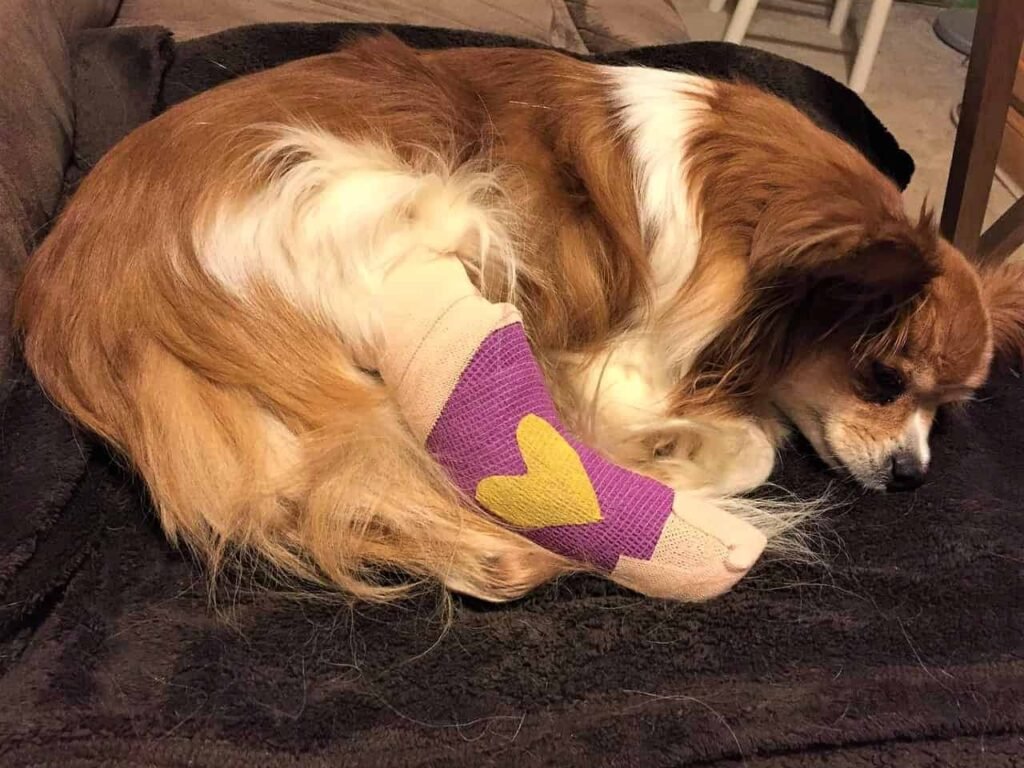How to Treat Dog Paw Pad Cuts at Home

Dogs don’t wear shoes and their primary mode of transportation is their paws. As a result, it is not uncommon for them to have paw pad injuries. Especially, if they walk on rough broken glass, hot sidewalks, or chemicals that blister their paws. Hence, you need to know how to treat dog paw pad cuts at home so that you can administer first aid treatment to your dogs to reduce their pain.
This blog post will guide you on how to treat dog paw cuts at home effectively, ensuring the well-being and speedy recovery of your pup. It will provide you with step-by-step instructions on how to clean, bandage, and protect your dog’s paw cut.
This will save you from spending so much money and time at the vet clinic. But first, let’s begin with the different types of dog paw pad cuts and their causes.
Different Types of Dog Paw Pad Injuries and Their Causes
- Cuts and abrasions: These are the most common type of paw pad injury. They can be caused by stepping on sharp objects, running on rough surfaces, or being in a fight.
- Puncture wounds: These injuries are caused by sharp objects that penetrate the paw pad. They can be very deep and difficult to clean.
- Burns: Burns can be caused by hot surfaces, chemicals, or even sunlight. They can be very painful and can lead to infection.
- Frostbite: This is a type of cold injury that can damage the paw pads. It is most likely to occur in dogs with thin paw pads or in dogs that are exposed to cold temperatures for long periods of time.
- Allergic reactions: Allergies can cause the skin on the paws to become red, itchy, and inflamed. This can lead to licking and chewing, which can further injure the paws.
- Infections or infestations: These are conditions that involve the invasion of bacteria, fungi, parasites, or viruses into the paw pad. Infections or infestations can cause redness, pus, odor, or lesions on the paw pad.
- Cracks: The paw pads are made up of tough, thick skin, but they can still crack, especially in the winter when the skin is dry and cold. Cracks can be painful and can lead to infection.
- Chemical burns: Chemicals can cause burns on the paw pads, especially if they are concentrated or if they are left on the skin for a long period of time. Chemical burns can be very painful and can lead to infection.
Read about how to tackle limping in dogs in case your dog starts limping after getting a cut paw pad.

What are the signs of a dog paw pad cut?
The signs of a dog paw pad cut can include:
- Limping
- Licking or chewing the paws
- Redness or swelling
- Pain
- Bleeding
How to Treat a Dog Paw Injury at Home
Here are the steps on how to treat a dog paw cut at home:
Step 1: Assess the severity of the cut.
The first step in how to treat dog paw pad cuts is to know how bad the injury is. Knowing the severity of the cut will help you determine whether it is something you can treat at home or an emergency that needs a vet.
If the cut is minor, you can treat it at home. You can clean wounds that are smaller than a half-inch in diameter with an antibacterial wash and wrapped in a light bandage at home.
If the cut is deep or bleeding heavily, or if your dog is showing signs of pain or distress, then take them to the vet immediately.
Step 2: Remove any debris from the wound.
Use clean tweezers to carefully remove any dirt, thorns, gravel, twigs, or other debris from the wound. However, most minor cuts that you can handle by yourself won’t have debris, especially glass.
For these more serious injuries, you should seek the advice of a vet on how to safely take out the debris.
Step 3: Clean the cut
After removing the debris, clean the wound with soap and water. Use a mild soap and warm water to clean the wound and be sure to rinse the wound thoroughly. Another good way to soak the feet is to use warm water with Epsom salts. Before you put on any bandage, dry the foot well.
Step 3: Apply an antibiotic ointment or balm on the wound.
Apply a thin layer of antibiotic ointment to the wound to help prevent infection. Also, applying paw balm can help healing by keeping the paw moist to stop drying or cracking. However, balms are only for very minor cuts and scrapes, as putting balms on deeper wounds can push in more dirt and make the healing take longer.
Step 4. Bandage the wound.
To prevent dirt and licking or biting, you can cover the wound with a bandage. But don’t make it too tight and take your dog to the vet as soon as possible. You can also use clean socks and some tape to protect the paw. Remember to remove the bandages after a while because they can make the skin wet and infected.
Step 5. Monitor your dog’s paw.
Check the wound regularly for signs of infection, such as redness, foul odor, swelling, or pus. Also, change the bandage at least once a day or whenever it gets wet or dirty. If you see any signs of infection, take your dog to the vet.
You may also like to read about how to Treat A Dog Stye At Home.

How to Bandage a Dog Paw Wound Using a Bandage:
Earlier, we saw that in the process of treating dog paw cuts, you need to bandage the wound to prevent dirt, licking, and biting. Now, let’s go over the step-by-step process of bandaging the cut paw pad of a dog.
- Gather your supplies: You will need a non-stick gauze pad, a roll of gauze bandage, medical tape, and scissors.
- Clean the wound: Use a mild soap and water solution to clean the wound. Be sure to dry the area thoroughly before applying the bandage.
- Place the gauze pad over the wound: Make sure the pad is large enough to cover the entire wound.
- Start wrapping the gauze bandage around the paw: Start at the toes and work your way up the leg. Overlap each layer of gauze by about 50%.
- Secure the bandage with medical tape: Apply the tape in a criss-cross pattern to help keep the bandage in place.
- Trim any excess gauze.
- Check the bandage regularly to make sure it is not too tight: The bandage should be snug, but not so tight that it cuts off circulation.
- Change the bandage every 24-48 hours, or more often if the bandage becomes dirty or wet.
Here are some additional tips for wrapping a dog paw wound:
- If the wound is on the bottom of the paw, you may want to leave the toes exposed so that you can check for swelling or coolness.
- If your dog is likely to chew at the bandage, you may want to use a bootie or sock to help keep it in place.
- If the wound is deep or bleeding heavily, you should take your dog to the vet for treatment.
Here is a video that shows How to bandage your pet’s paw in case of an emergency.
How to Help Your Dog’s Paw Pad Injury to Heal Quickly
After administering first aid treatment to your dog, here are some actionable tips on how to help a dog paw pad injury heal quickly:
- Give your dog pain medication: This will help to keep your dog comfortable while the wound heals. Your vet can prescribe pain medication for your dog.
- Keep the wound elevated: This will help to reduce swelling and pain. You can elevate your dog’s paw by placing it on a pillow or towel.
- Change the bandage regularly: Checking and changing the bandage at least once a day or whenever it gets wet or dirty will prevent infection and monitor healing progress. Look for signs of infection, such as redness, swelling, pus, or foul odor. If you notice any of these, take your dog to the vet immediately.
- Keep the wound dry: This will help to prevent infection. If your dog’s paw gets wet, be sure to dry it thoroughly.
- Avoid walking your dog on hard surfaces: This will help to prevent further injury to the paw pad. If you must walk your dog, be sure to use booties or socks to protect their paws.
- Use a product specifically designed for paw pad injuries: There are a number of products available that can help to soothe and heal paw pad injuries. These products usually contain ingredients such as aloe vera, witch hazel, or chamomile.
- Avoid using human medications on your dog’s paw pad: Human medications can be toxic to dogs, so it is important to use only products that are specifically designed for dogs.
- Be patient: It takes time for paw pad injuries to heal. Be patient and follow the instructions of your vet to help your dog’s paw pad heal as quickly as possible.
UNRELATED: Read this article to learn about dog breeding for beginners.
How Much Time Does it Take for the Paw Pad to Heal?
The time it takes for a paw pad to heal depends on the severity of the injury. Minor cuts and abrasions may heal in as little as 7-10 days, while more serious injuries, such as puncture wounds or burns, may take 2-3 weeks or longer to heal.
Here is a table that summarizes the factors that can affect the healing time of a dog’s paw pad injury:
| Factor | Effect on Healing Time |
|---|---|
| Size and depth of the injury | Larger and deeper injuries will take longer to heal. |
| Location of the injury | Injuries on the bottom of the paw may take longer to heal than injuries on the top of the paw. |
| Overall health of the dog | Dogs with underlying health conditions may take longer to heal from injuries. |
| Level of care provided | Providing proper wound care and keeping the paw pad clean and dry can help to speed up the healing process. |
You should follow the first aid steps I mentioned above and if you are concerned about the healing time of your dog’s paw pad injury, be sure to talk to your veterinarian. They can assess the severity of the injury and recommend the best course of treatment.
Should I Let My Dog Lick its Cut Paw?
It is not advisable to let your dog lick its cut paw. While dog saliva does have some antiseptic properties, these are often minor compared to the potential bacteria that may be introduced. In fact, licking can introduce more bacteria into the wound, leading to secondary infections, hot spots, soreness, or self-mutilation.
Here are some of the reasons why you should not let your dog lick its cut paw:
- Dog saliva can introduce bacteria into the wound. The bacteria in your dog’s mouth can be harmful to humans, and they can also be harmful to dogs. If your dog licks its cut paw, the bacteria from its mouth can enter the wound and cause an infection.
- Licking can irritate the wound. The rough surface of a dog’s tongue can irritate a cut paw, making it more painful and slowing down the healing process.
- Licking can remove medication from the wound. If you have applied medication to the wound, licking can remove it, making it less effective.
- Licking can make the wound worse. If your dog licks the wound too much, it can actually make the wound worse by reopening it or causing it to bleed more.
Therefore, you should try to prevent your dog from licking its cut paw by using one of the following methods below.

Tips to prevent your dog from licking its cut paw
1. Use a cone or Elizabethan collar to prevent your dog from licking the wound:
A cone or Elizabethan collar is a plastic or fabric collar that fits around your dog’s neck and prevents them from reaching their paws. This is the most effective way to prevent your dog from licking its cut paw.
2. Apply a bitter apple spray to the wound to make it taste bad:
Bitter apple spray is a bitter-tasting spray that can be applied to a wound to make it taste bad to dogs. This can help to deter your dog from licking the wound.
3. Distract your dog with toys or treats when it tries to lick the wound:
If your dog starts to lick its cut paw, you can try to distract them with toys or treats. This can help to keep their attention away from the wound.
4. Take your dog for short walks so that it does not have as much opportunity to lick the wound:
If your dog is not able to reach its paws when it is walking, it will be less likely to lick the wound. Taking your dog for short walks can help to prevent them from licking the wound.
5. Use a surgical suit or a T-shirt:
You can use a specially designed suit that covers your dog’s body and protects the wound from licking. Alternatively, you can use a T-shirt that fits snugly around your dog’s torso and extends to cover its paws. You should make sure the suit or shirt is clean and dry and does not restrict your dog’s movement.
By following these tips, you can help to prevent your dog from licking its cut paw and promote quick recovery.
When Should I Take My Dog to the Vet to Treat a Cut Paw Pad?
There are many reasons to take your dog to see the vet but if you notice any of these things, contact the veterinarian immediately.
- The wound is deep, large, or bleeding profusely. This means that the wound is severe and may damage the underlying tissue, bone, or blood vessels. It may also cause excessive blood loss and shock.
- The wound does not stop bleeding after applying pressure for 10-15 minutes. This means that the wound is not clotting properly and may require stitches or other medical interventions to stop the bleeding.
- The wound has a foreign object embedded in it that you cannot remove easily. This means that the wound may be contaminated or irritated by the foreign object and may cause infection or inflammation. The foreign object may also damage the tissue or nerves if left in place.
- The wound shows signs of infection, such as redness, swelling, pus, or foul odor. This means that the wound is infected by bacteria or fungi and may cause pain, fever, or systemic illness. Infection can also delay healing and increase scarring.
- The wound does not heal or improve after 7 days of home treatment. This means that the wound is not healing properly and may have complications such as chronic inflammation, granulation tissue, or proud flesh. It may also indicate an underlying health problem that affects wound healing, such as diabetes or immune deficiency.
- Your dog is in severe pain, limping, or refusing to walk on the injured paw. This means that your dog is suffering from the wound and may have nerve damage, joint injury, or bone fracture. It may also affect your dog’s quality of life and mobility.
How Much Does it Cost to Treat a Dog Paw Pad Injury?
The cost of treating a dog paw pad injury can vary depending on the severity of the injury, the location of the injury, and the type of treatment required. However, in general, you can expect to pay anywhere from $50 to $500 for treatment.
Here is a breakdown of the factors that can affect the cost of treating a dog paw pad injury:
- The severity of the injury: The more severe the injury, the more expensive the treatment will be. For example, a deep cut that requires stitches will be more expensive to treat than a small scrape.
- Location of the injury: Injuries on the bottom of the paw are more likely to become infected because they are more likely to come into contact with dirt and bacteria. As a result, injuries on the bottom of the paw will typically be more expensive to treat.
- Type of treatment required: The type of treatment required will also affect the cost of treatment. For example, if the injury requires stitches, the cost of treatment will be higher than if the injury can be treated with a bandage.
- The location of the veterinarian: The cost of veterinary care can vary depending on the location of the veterinarian. For example, veterinary care in a major city will typically be more expensive than veterinary care in a rural area.
- The experience of the veterinarian: The experience of the veterinarian can also affect the cost of treatment. A veterinarian with more experience may charge more for their services.
By talking with your vets, they may recommend a less expensive treatment option or they may be able to work with you to create a payment plan.
How to Prevent Paw Pad Cuts
Here are some actionable tips on how to prevent dog paw pad cuts:
- Keep your dog’s paws clean and dry. This will help to prevent dirt and bacteria from building up on the paws, which can lead to cuts and infections.
- Avoid walking your dog on hot or rough surfaces. Hot pavement can burn your dog’s paws, and rough surfaces can cause cuts. If you must walk your dog on these surfaces, be sure to use booties or socks to protect their paws.
- Trim your dog’s nails regularly. Long nails can make it easier for your dog to cut their paws on sharp objects.
- Use a paw balm or moisturizer. This can help to keep your dog’s paws soft and protected.
- If you live in an area with hot summers, consider buying booties or paw wax for your dog. This will help protect their paws from the heat and prevent them from getting burned.
- Avoid using harsh chemicals on your dog’s paws. These chemicals can irritate the paws and make them more susceptible to cuts.
- Supervise your dog when they are playing outside. This will help to prevent them from stepping on sharp objects or getting their paws caught in things.
- If your dog is prone to paw pad cuts, you may want to keep a first-aid kit on hand. This kit should include bandages, antibiotic ointment, and pain medication.
- If your dog does get a paw pad cut, be sure to clean the wound thoroughly with soap and water. You can then apply antibiotic ointment and bandage the wound. If the wound is deep or bleeding heavily, you should take your dog to the vet.

FAQs About How to Treat Dog Paw Pad Cuts
Is it necessary to visit a veterinarian for every paw cut?
Not necessarily. Minor paw cuts can be treated at home with basic first aid. However, if the cut is deep, bleeding heavily, or appears infected, it is best to take your dog to the vet.
Can I bathe my dog while the paw cut is healing?
Yes, you can bathe your dog while the paw cut is healing. However, you should avoid getting the wound directly wet. If you do get the wound wet, be sure to dry it thoroughly afterward.
Will a dog’s paw pad heal on its own?
Yes, a dog’s paw pad will heal on its own in most cases. However, it is important to keep the wound clean and protected to prevent infection. You should also monitor the wound for signs of infection, such as redness, swelling, or discharge.
Should I remove the bandage when my dog is resting?
No, you should not remove the bandage when your dog is resting. The bandage helps to protect the wound from dirt and bacteria, which can lead to infection. If your dog is licking or chewing the bandage, you may need to use an Elizabethan collar to prevent them from doing so.
How long does it take for a dog paw cut to heal?
The time it takes for a dog paw cut to heal depends on the severity of the cut. Minor cuts may heal in a few days, while more serious cuts may take several weeks to heal.
Can I use human first aid supplies to treat my dog’s paw cut?
In most cases, you can use human first aid supplies to treat your dog’s paw cut. However, there are a few things to keep in mind. First, you should avoid using hydrogen peroxide to clean the wound. Hydrogen peroxide can damage the tissue and slow down the healing process. Second, you should use a bandage that is specifically designed for dogs. Human bandages can be too tight and can restrict blood flow to the paw.
Conclusion
So, there you have it! These are the basic steps on how to treat dog paw pad cuts at home. It’s important to remember that every dog is different, so what works for one dog may not work for another. If you’re ever unsure about how to treat a dog paw pad cut, it’s always best to err on the side of caution and take your dog to the vet.
But with a little bit of care and attention, most dog paw pad cuts will heal quickly and without any complications. And in the meantime, you can rest easy knowing that you’re doing everything you can to keep your furry friend comfortable and healthy.
Remember that paw pads are essential for dogs to walk and explore the world around them. By taking care of your dog’s paw pads, you’re not only helping them heal from a cut, but you’re also helping them stay healthy and active.
References
- Better Pet – How to treat cuts on your dog’s paws
- Ferguson Animal Hospital – What Should I Do if My Dog Has Cut His Paw Pad?
- VCA Animal Hospitals – First Aid for Torn or Injured Foot Pads in Dogs





